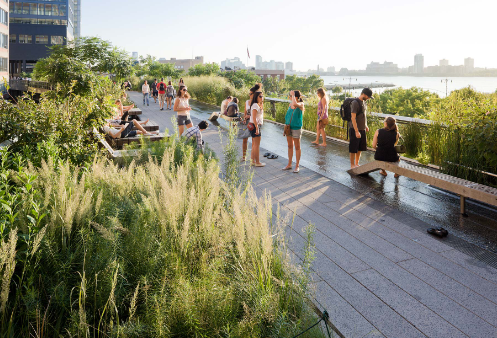The High Line: A Landmark in Landscape Architecture
The High Line, an elevated linear park built on a former railway line in Manhattan, stands as a testament to innovative urban landscape architecture. Transforming an underutilized space into a vibrant community hub, it highlights the fusion of nature and urban design. Understanding its design and impact can inspire future projects and inform how cities can creatively reclaim public spaces.
Reimagining Urban Spaces
The High Line is a prime example of how landscape architects can creatively repurpose urban infrastructure. Originally constructed in the 1930s to elevate freight trains, the railway fell into disuse by the 1980s, becoming a neglected area teeming with weeds. The project began in 2009, led by landscape architects James Corner Field Operations, and aimed to create a green corridor that would offer both recreational space and ecological benefits. This conversion highlights the potential of reimagining urban structures, encouraging cities to think outside the box when it comes to development.
Design Elements that Inspire
At the heart of the High Line’s design are its thoughtful landscaping and engaging features. It blends native plants with artistic elements, such as integrated seating areas and public art installations. The design emphasizes seasonal changes, showcasing diverse foliage that varies throughout the year. Visitors enjoy meandering walks through lush plant life while also experiencing stunning views of the city’s built environment. Such design elements enhance the park’s aesthetic appeal and promote biodiversity, demonstrating how urban parks can coexist with nature.
Community Engagement and Cultural Impact
The High Line has become a cultural hotspot, attracting millions of visitors each year and revitalizing the surrounding neighborhood. It serves as an outdoor gathering space, hosting performances, art shows, and educational programs that engage the local community. This vibrant atmosphere encourages social interaction and fosters a sense of belonging. By prioritizing community engagement in its design, the High Line exemplifies how landscape architecture can create spaces that encourage civic pride and enhance urban life.
Conclusion
The High Line is more than just a park; it is a groundbreaking example of landscape architecture that promotes sustainability, community, and creativity. By learning from this project, cities around the world can take inspiration from the High Line to transform neglected spaces into vibrant urban sanctuaries. If you’re intrigued by the potential of landscape architecture, consider exploring local parks in your area or participating in community projects aimed at enhancing public spaces.

